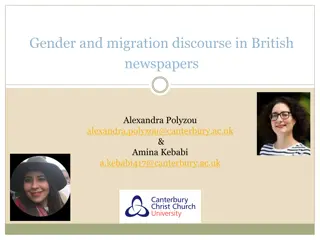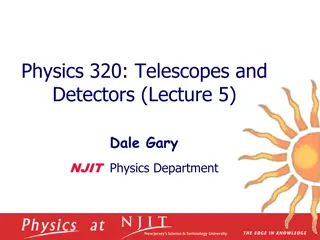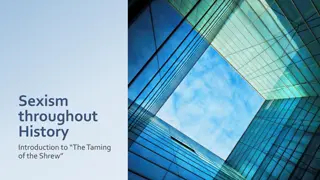Exploring the Purpose and Features of Newspapers Through a Historical Lens
This engaging piece delves into the fundamental aspects of newspapers, focusing on their purpose and features. It discusses how newspapers from the past, such as one from the summer of 1914, informed and entertained readers about important current events like the outbreak of World War One. The content also highlights the key features of a newspaper, including headline, byline, opening details, time connectives, and more. Additionally, it explores a recent article about driverless cars being tested in London, showcasing the evolving nature of news reporting.
Download Presentation

Please find below an Image/Link to download the presentation.
The content on the website is provided AS IS for your information and personal use only. It may not be sold, licensed, or shared on other websites without obtaining consent from the author.If you encounter any issues during the download, it is possible that the publisher has removed the file from their server.
You are allowed to download the files provided on this website for personal or commercial use, subject to the condition that they are used lawfully. All files are the property of their respective owners.
The content on the website is provided AS IS for your information and personal use only. It may not be sold, licensed, or shared on other websites without obtaining consent from the author.
E N D
Presentation Transcript
What is a newspaper and what is its purpose?
Purpose of a newspaper To inform the reader (in an entertaining way) of important current events or issues that are going on in the world.
Lets have a look at one now A newspaper from the summer of 1914 How does this newspaper inform the reader (in an entertaining way) of important current events or issues that are going on in the world? Image result for ww1 clipart
Features of a newspaper Features are the stuff, or the things, or the ingredients that go into a text to make it what it is. For example, the features of a horror story would be a spooky setting, tense writing and an exciting event! From reading this newspaper about the outbreak of World War One, what do you think the features of a newspaper might be?
Features of a newspaper Features of a newspaper Headline Byline Opening the 5Ws! Time connectives and fronted adverbials Relative clauses Direct speech Reported speech Third person Past tense Closing
Driverless cars to be Driverless cars to be tested in London ahead of tested in London ahead of launch this Christmas launch this Christmas Driverless cars are to be tested on the streets of London this week as part of a plan to deploy the UK's first completely autonomous fleet on British roads by Christmas. A Government- backed committee will deploy cars to map the streets of Hounslow in West London to teach them to understand road signs and lane markings following successful tests in Oxford. What? What? When? When? Where? Where? Who? Who? Why? Why? _______________________ _______________________ _______________________ _______________________ _______________________ _______________________ _______________________ _______________________ _______________________ _______________________ _______________________ _______________________ _______________________ _______________________ _______________________ _______________________ _______________________ _______________________ _______________________ _______________________
Why do newspapers use inverted commas (speech marks)?
What is the essential checklist What is the essential checklist for direct speech? for direct speech? ABC writing the sentence using closing punctuation ! ? , writing who said it and how it was said.
What is reported speech? Reported speech is when we tell someone what someone else has said but we don t report it word for word.
Reported speech checklist Reported speech checklist a noun or pronoun for the third person. a verb that means said. the word that. the past tense.
Speech Word Bank Speech Word Bank Synonyms of said Adverbs Don t forget that you can use adverbs that start with the word with or in followed by the word or root word from the list below. (Warning: doesn t work with all of them)! announced claimed declared remarked replied stated suggested told fumed joked screamed shouted added commented recalled revealed answered described explained reckoned blurted questioned gleefully honestly nervously politely quickly rudely seriously bravely eagerly inquisitively kindly merrily angrily brightly defiantly happily irritably sharply anxiously boastfully cheerfully dramatically speedily unexpectedly
Features of a newspaper Features of a newspaper Headline Byline Opening the 5Ws! Time connectives and fronted adverbials Relative clauses Direct speech Reported speech Third person Past tense Closing
Your task today will be to write a newspaper article on a topic of your choice. Before you start writing, you need to produce a small plan to help jot down your initial ideas, so you have a structure when writing. On the following slide will be suggested topics that you may wish to write about. Suggested structure: Suggested structure: Opening paragraph (5 W s) Paragraph one Paragraph two Paragraph three Closing paragraph You may wish to include a photo and caption. Your plan can be either notes or verbally to an adult or a sibling.
Possible topics for your newspaper article. The government are only serving healthy food at lunch (including no pudding except fruit). WW1 (you showed a great understanding of this). A sports team having their first win in over 10 years. The Wright Brothers create the first successful aircraft.
Things to consider Opening paragraph This can be straight to the point but must make the reader want to read on (you can not literally answer the 5W s). Main point paragraphs New point new paragraph. Remember to vary your use of direct and reported speech. You want to discuss the main events that have already happened (hence the past tense). Closing paragraph You want to update the reader on where the situation is currently at. Remember, if you are writing about something that has already happened, pretend to be in that moment (as you can see in the example). Write your newspaper article in your green book. You may want to draw lines or stick lined paper in to make sure that your writing is neat.
Does it make sense? When you re happy with it, read your story to someone in your house. Did it persuade them?























